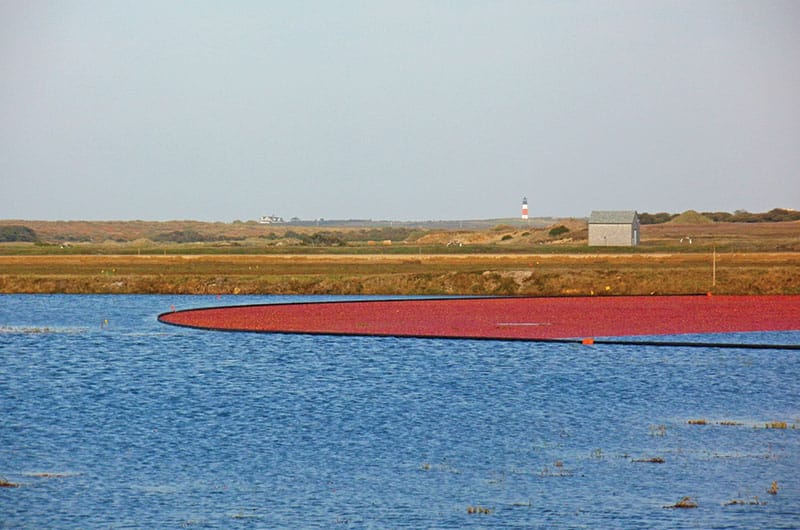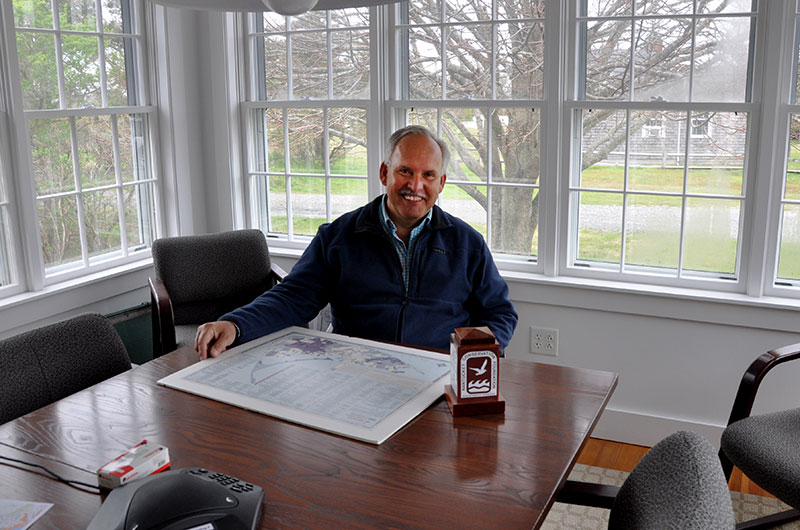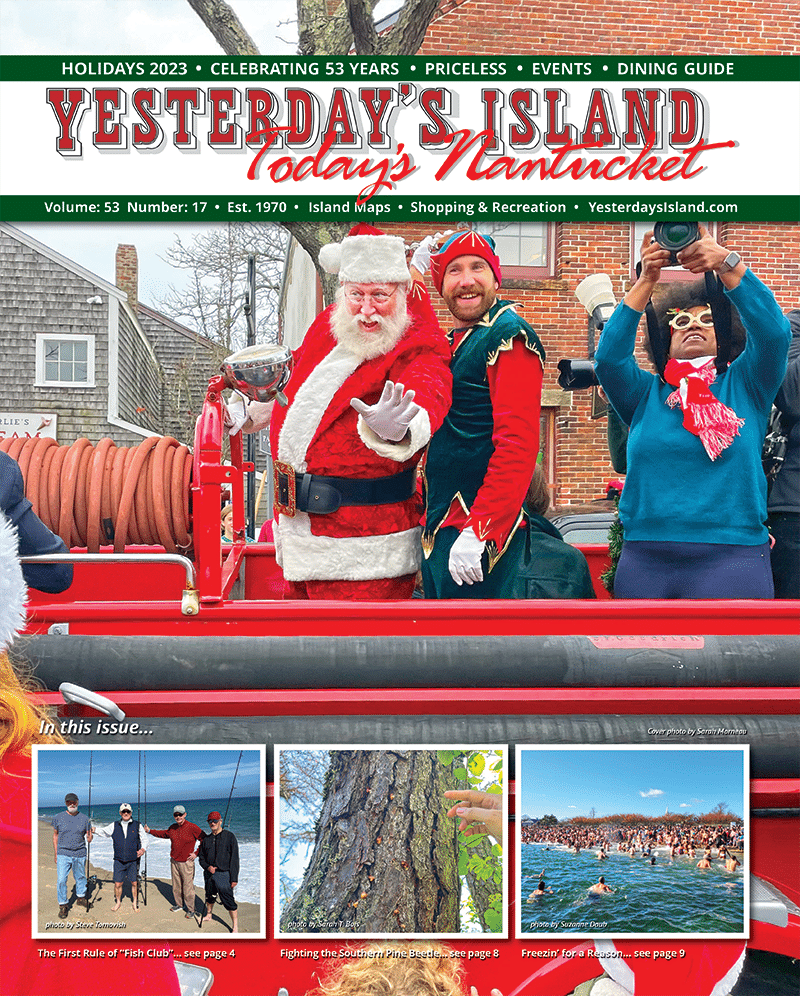~ by Carl Oscar Olson ~

The first donation (and one of the smallest) occurred in 1963 and was given by Frances C. Cook. Just under an acre of land off of North Beach Street in the Brant Point area of town was destined to be a sanctuary for our feathered friends. Though its inhabitants took flight, this parcel of land was symbolic of The Foundation’s grounded and humble beginnings. This initial gift was the spark that started the fire in the minds of concerned residents and resulted in the giving of approximately 6,500 acres, over three quarters of the Foundation’s current total 8,853 acres. That is almost 1/3 of the entire landmass of Nantucket.
Some say size doesn’t matter. When it comes to preserving the beauty and character of the environment surrounding us this is especially true. The largest donation of land, however, is worth a tip of the hat. Given that the cranberry has long been a trademark of New England and especially the Massachusetts coastline, it’s fitting that the most sizable gift to date was the 737 acre Milestone Cranberry Bog. This generous and functional contribution was given collectively by Walter Beinecke, The Larson Family, and The Nantucket Ornithological Association. The Milestone Bog is one of two remaining commercial bogs in operation on the island. Not only is the NCF helping to maintain Nantucket’s 200 year old history of harvesting cranberries, the bogs and surrounding land are just another one of the unique and fragile ecosystems they are dedicated to protecting.

In 1971, seven years after its conception, the NCF hired their first official employee. As a young man from western Massachusetts who ventured to the island on two occasions in the early 1960’s with the cub scouts, Jim Lentowski fell in love with the scenery and character of the island at an early age. He later returned as a graduate student studying Landscape Architecture, visited the field station and gained some exclusive access to a sort of “behind the scenes” Nantucket. Soon after, Jim heard tell of a position with a burgeoning conservation foundation and submitted his application. He says he was told to “start from scratch” in the most literal way; a desk and a pencil was just about all he had to work with. In the same year, The Foundation acquired The Ram Pasture and The Woods, two properties including Sanford Farm that are some of the most popular today. The land was purchased for $625,000 and was paid for in part by The Foundation’s first fund raising campaign. Jim’s first job and first as the first employee was to track down funds to pay off the rest of the debt.
Fifty years later, Jim continues to wear the hat as the Foundation’s longest running employee. Though his roles have changed through the years, the passion he has for protecting the beauty of the island has not. Today he is the Executive Director of the Nantucket Conservation Foundation.
From a bird’s eye view it really is quite astonishing just how much open space still exists on Nantucket, much of which remains pristine and untouched. The most important thing to understand, however, is that this did not happen by accident. One may shudder to imagine the island’s appearance if not for the foresight and generosity of the original founders of the NCF: Walter Beinecke Jr., Tell Berna, Alcon Chadwick, Frederick W. Haffenreffer, Roy E. Larsen, John L. Lyman, Robert F. Mooney, W. Ripley Nelson, and Charles G. Snow. There is no doubt about it, the best way to go about protecting something is really quite simple: Own it. With so much rare beauty to behold on Nantucket, it must have been easy just a generation ago to wander onto a property one might assume to be public. Being greeted by a sign reading PRIVATE PROPERTY or NO TRESPASSING must have caused dismay for many, but not anymore. “We have traditionally been after properties taken for granted by the public.” Jim stated. This in a way is the mantra of the NCF. Acquire what is private, protect it, and open it for the public to enjoy.
Nantucket is home to many rare plants, animals, and resources, unique habitats such as sandplain grasslands, and the highest percentage of rare species in the state. Certain plants, once common throughout the state, can now only be found on Nantucket. This is due in large part to the conservation efforts of The Foundation. According to the National Heritage and Endangered Species program and the Massachusetts Division of Fisheries and Wildlife, one example of this is the Eastern Silvery Aster (Symphyotrichum concolor). The lilac-flowered plant thrives in dry, sandy soil. Other efforts seek to help animals being displaced for unknown reasons, such as the American Burying Beetle (Nicrophorus americanus). Once widespread in North American, the beetle is considered endangered on both state and federal lists. Researchers hope to learn more about the animal and it’s behavior, and Nantucket is one of the few places this is taking place.
There are research projects ongoing throughout the year. Some projects help to curb the natural and unnatural decimation of a variety of habitats, such as prescribed fire effects research. Given the numerous grasslands and dry shrubbery (largely due to past human interference) on Nantucket, wildfire is a constant and easily spread threat. Burning prescribed and controlled fires has been a human practice for thousands of years, one that is currently being researched and implemented on the island in an effort to prevent future catastrophe. There are many other ongoing projects that are meant to track and protect plants and animals on the island, many of which welcome help from residents and visitors. If you happen to see a tagged horseshoe crab in the coming months, be sure to call the NCF!
By working alongside The Properties Maintenance team, seasonal field assistants/volunteers, members are able to make the best decisions for land use. Since the island can’t possibly be set aside land solely for conservation, such entities as The Nantucket Land Council are involved as well. In this way, efforts are coordinated cohesively and dynamically, creating as much of a win-win situation as is possible.
Since there is much more to be done by the NCF’s members than simply procure and protect land, monetary gifts are of the utmost importance. Many of the properties are in need of constant maintenance and attention. As more and more people are welcomed onto the Foundation’s properties every coming season, this work becomes increasingly important. The Properties Maintenance team gets the job done in stride. They tend to tasks ranging from fencing and signage to keeping up with the Foundation’s many buildings and structures, and even keeping those few unruly guests in check. The team’s array of abilities allow for nearly all of the work to be carried out without having to involve third parties.
These days, the Island’s own nonprofit conservation organization is not being gifted much in the way of acreage. “Land acquisition is winding down.” says Lentowski. A growing population requires housing, schools, and property to meet the needs of the people. As Lentowski stated, “We’re currently working toward building on past accomplishments.” This means not only expanding on what’s currently owned, but also taking care of the land they are responsible for. This is no small feat considering the Foundation has just three people working on maintaining the 9,000 acres. There are many challenges facing conservation at this point, but the biggest for NCF are maintaining the properties and finding ways the NCF can use this land to educate the growing public to care for the gifts as well, ensuring it lasts for generations to come.
The day before the last surviving founder of The Nantucket Conservation Foundation will be put to rest in the earth he helped to preserve, Jim said, “The founders wouldn’t just be satisfied with our progress since the beginning, they’d be jubilant.”
To learn more about the Nantucket Conservation Foundation, please visit their website at nantucketconservation.org. Participate in one of their walking tours, purchase apparel, or simply make a donation.


